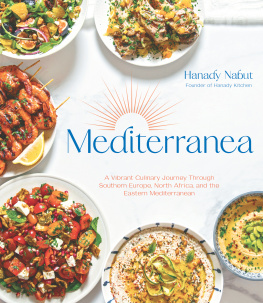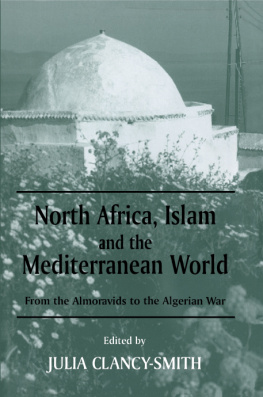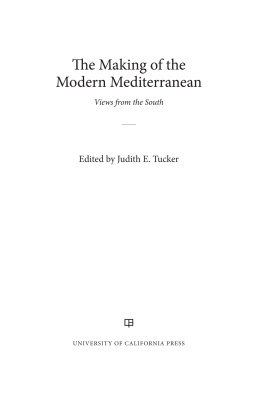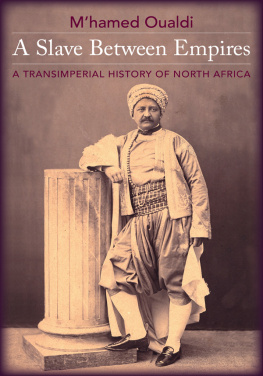THE FLETCHER JONES FOUNDATION
HUMANITIES IMPRINT
The Fletcher Jones Foundation has endowed this imprint to foster
innovative and enduring scholarship in the humanities.
The publisher gratefully acknowledges the generous support
of the Fletcher Jones Foundation Humanities Endowment
Fund of the University of California Press Foundation.
Mediterraneans
THE CALIFORNIA WORLD HISTORY LIBRARY
Edited by Edmund Burke III, Kenneth Pomeranz, and Patricia Seed
1. The Unending Frontier: Environmental History of the Early Modern World, by John F. Richards
2. Maps of Time: An Introduction to Big History, by David Christian
3. The Graves of Tarim: Genealogy and Mobility across the Indian Ocean, by Engseng Ho
4. Imperial Connections: India in the Indian Ocean Arena, 18601920, by Thomas R. Metcalf
5. Many Middle Passages: Forced Migration and the Making of the Modern World, edited by Emma Christopher, Cassandra Pybus, and Marcus Rediker
6. Domesticating the World: African Consumerism and the Genealogies of Globalization, by Jeremy Prestholdt
7. Servants of the Dynasty: Palace Women in World History, edited by Anne Walthall
8. Island World: A History of Hawaii and the United States, by Gary Y. Okihiro
9. The Environment and World History, edited by Edmund Burke III and Kenneth Pomeranz
10. Pineapple Culture: A History of the Tropical and Temperate Zones, by Gary Y. Okihiro
11. The Pilgrim Art: Cultures of Porcelain in World History, by Robert Finlay
12. The Quest for the Lost Nation: Writing History in Germany and Japan in the American Century, by Sebastian Conrad; translated by Alan Nothnagle
13. The Eastern Mediterranean and the Making of Global Radicalism, 18601914, by Ilham Khuri-Makdisi
14. The Other West: Latin America from Invasion to Globalization, by Marcello Carmagnani
15. Mediterraneans: North Africa and Europe in an Age of Migration, c. 18001900, by Julia A. Clancy-Smith
16. History and the Testimony of Language, by Christopher Ehret
17. From the Indian Ocean to the Mediterranean: The Global Trade Networks of Armenian Merchants from New Julfs, by Sebouh David Aslanian
18. Berenike and the Ancient Maritime Spice Route, by Steven E. Sidebotham
Mediterraneans
North Africa and Europe
in an Age of Migration,
c. 18001900

Julia A. Clancy-Smith

University of California Press, one of the most distinguished university presses in the United States, enriches lives around the world by advancing scholarship in the humanities, social sciences, and natural sciences. Its activities are supported by the UC Press Foundation and by philanthropic contributions from individuals and institutions. For more information, visit www.ucpress.edu .
University of California Press
Berkeley and Los Angeles, California
University of California Press, Ltd.
London, England
2011 by The Regents of the University of California
Library of Congress Cataloging-in-Publication Data
Clancy-Smith, Julia Ann.
Mediterraneans : North Africa and Europe in an age of migration, c. 18001900 / Julia A. Clancy-Smith.
p. cm.
Includes bibliographical references and index.
ISBN 978-0-520-25923-2 (cloth : alk. paper)
1. EuropeansTunisiaTunisHistory19th century. 2. North AfricansTunisiaTunisHistory19th century. 3. ImmigrantsTunisiaTunisHistory19th century. 4. Tunis (Tunisia)History19th century. 5. AlgeriaHistory19th century. 6. EuropeEmigration and immigrationHistory19th century. 7. Africa, NorthRelationsEurope. 8. EuropeRelationsAfrica, North. I. Title.
DT269.T8C53 2011
304.86ndc22 2010019718
Manufactured in the United States of America
19 18 17 16 15 14 13 12 11
10 9 8 7 6 5 4 3 2 1
This book is printed on Cascades Enviro 100, a 100% postconsumer waste, recycled, de-inked fiber. FSC recycled certified and processed chlorine free. It is acid free, Ecologo certified, and manufactured by BioGas energy.
For our Tunisian family, friends, colleagues
and in memory of my brother, Martin Joseph (19512004)
CONTENTS
ILLUSTRATIONS
FIGURES
MAPS
ACKNOWLEDGMENTS
In the summer of 1973, a chartered plane landed in the Tunis-Carthage airport on the last leg of its journey from the United States to North Africa. On board were scores of new Peace Corps volunteers, recent graduates from American universities intending to teach English as a foreign language. I was among the volunteers, unaware at the time that this first encounter with Tunisia would grow into a lifelong friendship. A teaching post at al-Qayrawan in the interior made it feasible to travel though the south and the oases stretching from the Mediterranean coastline into Algeria. But much time was spent in Tunis, with its seductive madina as well as in nearby coastal villagesLa Marsa, Sidi Bou Said, Carthage, and La Goulettewhose hold over my imagination proved the most enduring. The present book has allowed me to write about the places and peoples that welcomed and intrigued me so long ago and that represent home and family even today.
As is often true of scholarship, this study came about by accident rather than design in a series of footnotes; those familiar with my first book will detect its influence. Years ago, more than I care to admit, I chased after Saharan rebels operating along the limits of the nineteenth-century Algerian and Tunisian states where a trans-Mediterranean traffic in contraband had sunk its runners deep into the desert, a trade that proved key to anticolonial resistance. As I excavated the tangled networks of exchanges contained in the documents, I confronted major problems in the secondary scholarshipmissing persons, floating frontiers, unsuspected mobilities, and unexplored connectivities. A range of peopleexpatriates, deserters, adventurers, and labor migrantsfrom all across the Mediterranean appeared in the primary sources but did not figure, at least not prominently, in that older historical narrative still structured around binaries, the French or Muslims and so forth. Directly related, the nation-state framework and nationalist narrative undergirding research on the modern Maghrib did not suffice. This earlier scholarship searched for, and found, a unique Tunisian (or North African) political identity and cultural personality solely grounded in Islam and Arabic and constructed against France and the French. But who were all these folks who kept popping up in the record and clearly belonged in the story as well? And what did their presence, permanent or transitory, in nineteenth-century North Africa mean for state, society, and local communities as well as for the Mediterranean world? Hopefully I have done justice to some of them, the historical subjects, as well as to the spaces through which they moveddespite the fact that their lives more frequently than not were reduced to a scribal notation, chance encounter, terse police or consular reports, or a long-forgotten ships manifest. Tracking people in motion for long stretches of time required generous patrons and substantial largesse.
My gratitude goes to the following institutions for financial support and/or for providing safe havens to write combined with intellectual camaraderie. First and foremost, the American Institute for Maghrib Studies and the Centre dtudes Magrbines Tunis (CEMAT), which saw this project through from start to finish; the American Philosophical Society; the Council for American Overseas Research Centers; the Getty Research Institute, Los Angeles; the Institute for Advanced Studies, Princeton; the National Endowment for the Humanities; the National Humanities Center; the Rockefeller Center, Bellagio; San Diego State University; the Spencer Foundation; University of Arizona, College of Social and Behavioral Sciences Research Institute; University of Arizona, Morris K. Udall Center for Studies in Public Policy; and the Virginia Foundation for the Humanities
Next page










